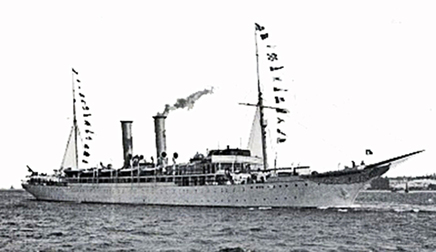Reference




OpenAI's Answer
The Prinzessin Victoria Luise holds the distinction of being the first purpose-built cruise ship due to several key reasons related to its design, intent, and historical significance.
1. Purpose-Built for Leisure Cruising
The Prinzessin Victoria Luise was specifically designed to serve as a leisure vessel, with the intention of offering passengers an experience dedicated to pleasure and tourism, rather than transportation. This was a significant departure from earlier ocean liners, which were typically built for transatlantic travel or other commercial purposes. While other ships had previously undertaken leisure voyages, none had been specifically constructed to meet the needs of passengers seeking luxurious, relaxing, and non-essential travel.
The vessel was commissioned by Albert Ballin, the head of the Hamburg-America Line (HAPAG), and was launched on June 29, 1900. Ballin’s vision was to create a ship that would cater exclusively to the growing demand for luxury cruises, aimed at the wealthy and those looking for a refined travel experience. The ship was designed with specific features like elegant interiors and state-of-the-art amenities that were geared towards comfort and leisure, further distinguishing it from earlier, more utilitarian ships.
2. Innovative Design and Amenities
Unlike earlier ships that were designed for function and speed, the Prinzessin Victoria Luise focused on comfort and luxury. It featured a lavishly decorated interior, with lounges, dining rooms, and other spaces aimed at ensuring that the journey itself was part of the vacation experience. This included a swimming pool (a rare luxury at the time) and a spacious promenade deck where passengers could relax and enjoy the surroundings, marking it as a precursor to the modern cruise ship experience.
The ship’s design was also influenced by the look of royal yachts, further enhancing its luxurious and exclusive appeal. Its elegant, sweeping lines and ornamentation were meant to evoke a sense of sophistication, setting it apart from other ships designed for general travel.
3. A Key Role in the Emergence of the Cruise Industry
The Prinzessin Victoria Luise is credited not only as the first purpose-built cruise ship but also as a significant milestone in the evolution of the modern cruise industry. It represented a shift in how people thought about travel, moving away from the necessity of transportation to the idea of voyages as a form of leisure, relaxation, and entertainment. This laid the groundwork for the expansion of cruising as a popular form of vacation travel in the 20th century.
This was especially significant at the turn of the 20th century, a time when steamships were primarily viewed as essential means of crossing the Atlantic. The Prinzessin Victoria Luise thus ushered in a new era where ships were designed as floating resorts, offering passengers an experience akin to a luxury hotel on the sea.
4. Historical Context
Before the Prinzessin Victoria Luise, ships like the SS Augusta Victoria (also owned by HAPAG) had been used for "pleasure voyages," but these were not specifically designed for leisure. They were traditional passenger ships that occasionally catered to tourists, rather than ships that were purpose-built for cruising. The Prinzessin Victoria Luise, in contrast, was conceived, planned, and constructed with leisure cruising as its sole purpose. It marked a clear distinction in the maritime industry between the traditional ocean liners and the cruise ships that would soon become the norm.
5. Cultural Impact
The ship’s role as the first purpose-built cruise ship was not just a technical and industrial achievement, but also a cultural one. It symbolized the beginning of a shift in societal attitudes towards travel. By offering an experience that combined the thrill of exploration with the comforts of a resort-style vacation, the Prinzessin Victoria Luise was instrumental in introducing the concept of cruising as a popular and prestigious way to travel.
In Conclusion:
The Prinzessin Victoria Luise is regarded as the world's first purpose-built cruise ship due to its design specifically tailored to leisure and tourism, its luxurious accommodations, and its pioneering role in shaping the cruise industry. Unlike earlier ships that occasionally carried tourists, this vessel was the first to cater exclusively to vacationing passengers, setting a standard for future cruise ships.